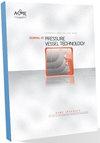Experimental Study On The Simulated Defects Detection In Submerged Transmission Pipeline
IF 1
4区 工程技术
Q4 ENGINEERING, MECHANICAL
Journal of Pressure Vessel Technology-Transactions of the Asme
Pub Date : 2023-08-30
DOI:10.1115/1.4063292
引用次数: 0
Abstract
Long-distance pipelines are commonly used to transport oil, natural gas, water, etc. However, long-term use without maintenance causes the residue in the pipeline to gradually settle inside the pipeline due to physical or chemical action, and the pipeline becomes an accident. This leads to overpressure and leakages in the pipeline, which in turn affects the safety of the industry and people's lives. The objective of this study is to develop a non-destructive inspection to measure defects in a water pipeline using an ultrasonic technique. The simulated pipe is a SCH80 carbon steel pipe with a standard thickness of about 11mm, and defects such as holes and grooves inside and outside the pipe were designed. A submerged ultrasonic transducer is used to evaluate the simulated pipe defects and acquire the defect data in an imaging system using LabVIEW and Origin software. As a result, the thickness and location of the defects are clearly evaluated. In addition, the ultrasonic detection error was calculated to be less than 6.5%. This helps to use this technique and equipment for the inspection of underground fluid pipelines.埋地输送管道模拟缺陷检测的实验研究
长距离管道通常用于输送石油、天然气、水等。然而,长期使用而不进行维护会导致管道中的残留物由于物理或化学作用而逐渐沉淀在管道内,从而导致管道发生事故。这导致管道超压和泄漏,进而影响行业和人民的生命安全。本研究的目的是开发一种使用超声波技术测量水管缺陷的无损检测方法。模拟管道为SCH80碳钢管,标准厚度约11mm,并设计了管道内外的孔洞和凹槽等缺陷。利用LabVIEW和Origin软件,在成像系统中使用浸没超声换能器对模拟管道缺陷进行评估并获取缺陷数据。因此,可以清楚地评估缺陷的厚度和位置。此外,经计算,超声波检测误差小于6.5%。这有助于将该技术和设备用于地下流体管道的检测。
本文章由计算机程序翻译,如有差异,请以英文原文为准。
求助全文
约1分钟内获得全文
求助全文
来源期刊
CiteScore
2.10
自引率
10.00%
发文量
77
审稿时长
4.2 months
期刊介绍:
The Journal of Pressure Vessel Technology is the premier publication for the highest-quality research and interpretive reports on the design, analysis, materials, fabrication, construction, inspection, operation, and failure prevention of pressure vessels, piping, pipelines, power and heating boilers, heat exchangers, reaction vessels, pumps, valves, and other pressure and temperature-bearing components, as well as the nondestructive evaluation of critical components in mechanical engineering applications. Not only does the Journal cover all topics dealing with the design and analysis of pressure vessels, piping, and components, but it also contains discussions of their related codes and standards.
Applicable pressure technology areas of interest include: Dynamic and seismic analysis; Equipment qualification; Fabrication; Welding processes and integrity; Operation of vessels and piping; Fatigue and fracture prediction; Finite and boundary element methods; Fluid-structure interaction; High pressure engineering; Elevated temperature analysis and design; Inelastic analysis; Life extension; Lifeline earthquake engineering; PVP materials and their property databases; NDE; safety and reliability; Verification and qualification of software.

 求助内容:
求助内容: 应助结果提醒方式:
应助结果提醒方式:


